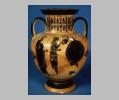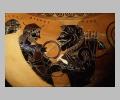|
| Collection: |
Museum of Fine Arts, Boston |
| Summary: |
Side A: Herakles and Apollo struggling for the tripod. Side B: Achilles receiving his armor from Thetis. |
| Ware: |
Attic Black Figure |
| Painter: |
Attributed to the Amasis Painter |
| Potter: |
Signed by Amasis |
| Context: |
Said to be from Orvieto |
| Date: |
ca. 525 BC - ca. 515 BC |
| Dimensions: |
H 0.304 m D 0.217 m |
| Primary Citation: |
ABV, 152.27; Para, 63; Beazley Addenda 1, 19; Beazley Addenda 2, 44 |
| Shape: |
Neck amphora |
| Beazley Number: |
310454 |
| Region: |
Etruria |
| Period: |
Archaic |
Condition:
Broken and repaired, with many missing fragments restored and repainted. The foot is modern. "Now augmented by fragments ex Philadelphia recognized by Payne." (ABV)
Decoration Description:
Side A: Apollo is shown attempting to take back the Delphic tripod from Herakles. Apollo wears a red fillet, a short chiton, and over that an elaborate leather corslet with scales on the upper parts, bands of decoration at the middle, and pteryges below the waist. Under the right armpit is an incised palmette. The god also carries a quiver with four arrows on his left side, hanging from a baldric. The shoulder folds of his chiton and the central stripe on his quiver are painted red. He is on the left hand side of the composition, facing right. He steps forward with his left foot and bends forward to grab the tripod. Over his head is the inscription *A*P*O*L*O*N ("Apollo"). Herakles stands on the other side, also stepping forward with his left foot and firmly grasping the tripod by a ring handle and one of the legs. The bowl of the tripod is painted red. He wears a stippled lionskin with the head drawn up like a hood, and a short red chiton underneath. He has a sheathed sword at his side, attached by a baldric, and a second baldric supports a quiver with four arrows at his back. The central panel of his quiver is red, as are some of the details of the lion's head he wears; the teeth of the lion are painted white. Behind his head is the partial inscription [[epig-rough]*E*R*A]*K*L*E*S ("[Hera]kles"). Between them, behind the tripod, stands Hermes. He is attempting to intercede in the fight. He has a fillet in his hair, and wears a red petasos tied under his chin, a chlamys decorated with an ornamental seam (some of the details painted red and white), a nebris, and boots (one painted red). He carries a caduceus (only the staff is preserved) in his left hand, and raises his right in alarm. Above his head is the (misspelled) inscription *Q*E*R*M*E*S ("Hermes"). A final inscription runs along the left side of the composition, behind Apollo's back, *A*M*A*S[*I*S] *M*E*P*O*I*E*S*E*N ("Amas[is] made me"). This subject is a common one in Greek art, appearing on the Siphnian Treasury at Delphi, and on more than 180 vases (von Bothmer, 135).
Side B: Achilles is shown receiving his armor from Thetis, in the presence of Phoinix. Achilles stands in the center of the scene, in profile to the right. He wears a fillet, chiton and corslet similar to Apollo's on Side A. He is also wearing greaves, and holding a spear in his left hand. With his right, he grasps by the nose guard the Corinthian high-crested helmet offered by his mother. The helmet has an incised (or perhaps relief) ram's head on the cheekpiece, and the crest is supported by a serpent. A sheathed sword is visible on his far side, but since there is no baldric, perhaps he holds it against his body with his arm. Above his head is the inscription *A*X*I*L*E*U*S ("Achilles"). In front of him, in profile to the left, stands his mother, Thetis. She wears a diadem with a serrated edge, a checkered peplos bordered with white dots, a necklace, and earrings; her skin is painted white. She carries a spear and Achilles' shield, with the shield device of a lion attacking a stag, and holds the helmet she's handing her son by the neck guard. Behind her head is the inscription *Q*E[*T]*I*S ("Thetis"). Phoinix stands behind Achilles on the left. He is bearded, balding, and has a wrinkled forehead; he wears a fillet, chiton and himation (both with decorated borders). He holds a spear in his left hand, and his right forearm is raised in greeting (the hand is missing). Above his head is the inscription *F*O*I*N*I*X*S ("Phoinix"). This scene could either be the first arming, before Achilles left for the Trojan War, or the second one, after Patrokles had been slain and Achilles' armor was stolen from the body.
On the neck of the vessel is a double palmette-lotus chain with horizontal bands of three lines above and below. There is a running scroll pattern framed by triple lines on the shoulder, which continues under the handles. At the root of the handles is a row of pendant filled triangles framed by two reserved bands above and three lines below. The handle sides are decorated with a large ornament of reverse volute scrolls composing a square; a small upright palmette over a large pendant rose occupies the vertical axis. Two large palmettes set on edge fill the interstices of the scrolls on the horizontal axis. Above the foot are staggered rays, and a key pattern framed by triple lines.
Inscriptions:
Side A, above the heads of the respective figures, *A*P*O*L*O*N ("Apollo"), [[epig-rough]*E*R*A]*K*L*E*S ("[Hera]kles"), *Q*E*R*M*E*S ("Hermes"). A final inscription runs along the left side of the composition, behind Apollo's back, *A*M*A*S[*I*S] *M*E*P*O*I*E*S*E*N ("Amas[is] made me"). Side B, above the heads of the respective figures, *A*X*I*L*E*U*S ("Achilles"), *Q*E[*T]*I*S ("Thetis"), *F*O*I*N*I*X*S ("Phoinix").
Collection History:
Ex coll. A. Bourguignon, acquired with amphora 01.8026; both vases said to be from Orvieto. H.L. Pierce Fund, 1901.
Sources Used:
Beazley 1951, 58; Boardman 1974, fig. 86; von Bothmer 1985, 134-37, no. 25; CVA, USA 14, Boston 1, pls. 27, 28.3; LIMC, I, pl. 109, Achilleus 508; Mommsen 1975, pl. 136; Schefold 1978, fig. 189, 270
Other Bibliography:
R. Bianchi Bandinelli and E. Paribeni L'arte dell' antichità classica. I Grecia (Turin, 1976) no. 292; D. von Bothmer "New Vases by the Amasis Painter" AK 3(1960) 71- 80; D. von Bothmer "The Arming of Achilles " Bulletin. BMFA 47 (1949) 88ff., fig. 7; Caskey 1922, 44; K. Friis Johansen The Iliad in Early Greek Art (Copenhagen, 1967) 124;N. Himmelmann-Wildschütz "Ein archaisches Gemälde vom Friedhof am Eridanos" AM 73(1958) 5, pl. 2.2; Hommages à Waldemar Déonna (Collection Latomus 28) (Brussells 1957), pl. 51,I; Hoppin 1924, 30-31; Jacobsthal 1927, pl. 24,d; S. Karouzou "Lekythos tou Amasi sto Ethniko Mouseio" AM 56(1931) 109; Karouzou 1956, pl. 33-34, 35.1-2; Korres 1970, pl. 11a; B. Legakis "A Lekythos signed by Amasis" AK 26 (1983) 73, fn. 6, 74, fn. 7; S. Luce "Studies of the Exploits of Herakles on Vases" AJA 34(1930) 323 no. 11; Perrot & Chipiez, 1911, vol. 10, 179, no. 1 and 184 ff., figs. 116-118; Pfuhl 1923, figs. 218-219; G.M. Richter Archaic Attic Gravestones (Cambridge Mass., 1944) 33

